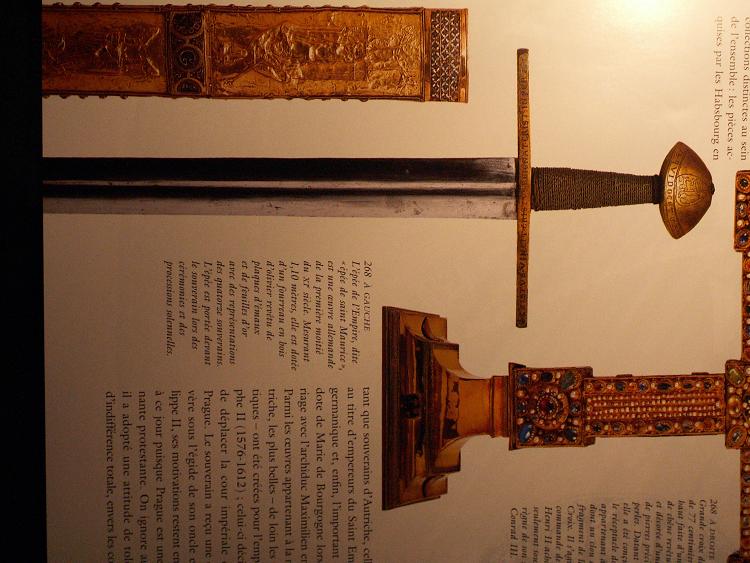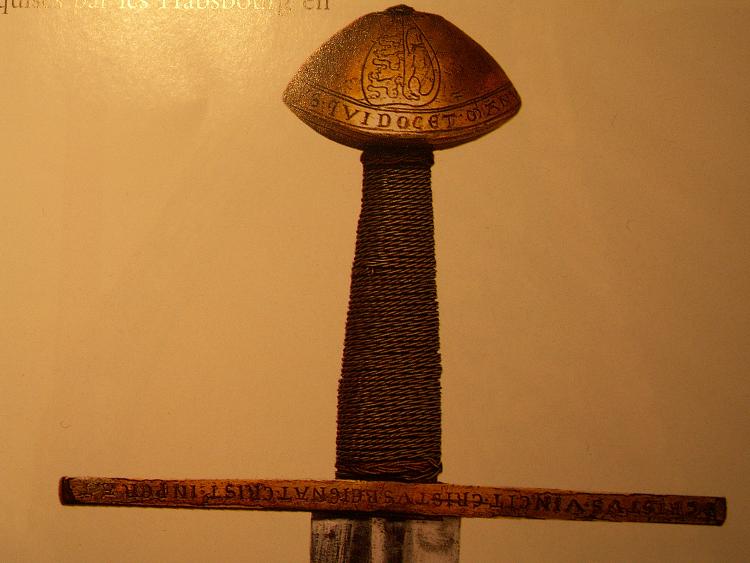So it looks like the sword has a Style 1 guard, correct?
I know that Peter Johnsson has documented the Vienna Maurice, but Albion doesn't intend to produce one because they don't want to tread on A&A's product line.
Seeing the full details of the original, I think Albion should reconsider. With the photos and specs kindly provided by Mr. Manouchehr, it's clear that the A&A Vienna is quite different from the real thing -- though no criticism of A&A is intended. Certainly A&A's version is a great piece of work, but it's only as accurate as any sword could be when it's reproduced from photos.
A reproduction based on full documentation needs to be made.
Perhaps Albion could build two versions:
1) The full-boat Museum Line version complete with gilt silver hilt. (Silver is currently around $14 per ounce, and if I had to guess I'd say there's around 12 ounces in hilt components, or $168 worth of silver. That's not a deal-breaker. The question is, can the engraved detail of the original be cast in silver, or is engraving the only real option?)
2) A Next Generation "fighting trim" version with iron hilt and no engraving.
Mr. Johnsson, if you're out there, I'd love to hear your thoughts on this.
Brian M
Seeing the full details of the original, I think Albion should reconsider. With the photos and specs kindly provided by Mr. Manouchehr, it's clear that the A&A Vienna is quite different from the real thing -- though no criticism of A&A is intended. Certainly A&A's version is a great piece of work, but it's only as accurate as any sword could be when it's reproduced from photos.
A reproduction based on full documentation needs to be made.
Perhaps Albion could build two versions:
1) The full-boat Museum Line version complete with gilt silver hilt. (Silver is currently around $14 per ounce, and if I had to guess I'd say there's around 12 ounces in hilt components, or $168 worth of silver. That's not a deal-breaker. The question is, can the engraved detail of the original be cast in silver, or is engraving the only real option?)
2) A Next Generation "fighting trim" version with iron hilt and no engraving.
Mr. Johnsson, if you're out there, I'd love to hear your thoughts on this.
Brian M
| Craig Peters wrote: |
| So it looks like the sword has a Style 1 guard, correct? |
I'd say it's a Style 1a guard. The Style 1 usually tapers toward the tips in all planes. The 1a is basically a rectangular rod that widens around the tang.
Since it doesn't taper to the tips when viewing it frontally, but does when viewed from above or below, I'd say it's closer to a Style 1a.
Dear friends,
In many pictures of the Reichsschwert in many pics, either the pictures are black and white or the color pics do not clearly show the gilding. The difference is in the book
Leimsider, Bruce.
1999 Le Trésor Impérial de Vienne. In: Guadalupi (ed.). Les Grands Trésors. Paris: Editions Gründ.
I am posting the pictures here. I had very bad lighting and sorry for the bad quality. I will take new pics in the daylight. If you look at teh left side of the quillon in the pic, you see the gilding is partially worn off and part of the silver is visible.
Kind regards
Manouchehr
 Attachment: 102.88 KB
Attachment: 102.88 KB

 Attachment: 77.62 KB
Attachment: 77.62 KB

In many pictures of the Reichsschwert in many pics, either the pictures are black and white or the color pics do not clearly show the gilding. The difference is in the book
Leimsider, Bruce.
1999 Le Trésor Impérial de Vienne. In: Guadalupi (ed.). Les Grands Trésors. Paris: Editions Gründ.
I am posting the pictures here. I had very bad lighting and sorry for the bad quality. I will take new pics in the daylight. If you look at teh left side of the quillon in the pic, you see the gilding is partially worn off and part of the silver is visible.
Kind regards
Manouchehr


I don't see a production model of this sword coming as plain silver, for some reason is not easy to come by, only sterling silver that patinates differently. I know Patrick Barta smelts his own silver but doesn't Mr. Barta do everything the right way? :)
Jeremy
Jeremy
| Jeremy V. Krause wrote: |
| I don't see a production model of this sword coming as plain silver, for some reason is not easy to come by, only sterling silver that patinates differently. I know Patrick Barta smelts his own silver but doesn't Mr. Barta do everything the right way? :)
Jeremy |
Jeremy,
Thank you very much for your input. As a matter of fact that was the reason that we had a division of labor for reproducing this sword. Mr. Rottler who is an experienced silver- and goldsmith made the pommel and the handguard (note two parts of the silver wrap of the handle are also gilded) and Mr. Johannes as an experienced smith made the blade.
The handguard and the pommel should be done via lost wax process. This is not an easy one. Maybe a good idea is that another custom piece is made of this sword.
Kind regards
Manouchehr
The sword appears to have a wire wrap grip. Is this original? (and in deed metal wire?)
| Elling Polden wrote: |
| The sword appears to have a wire wrap grip. Is this original? (and in deed metal wire?) |
Yes it is silver wire grip. The upper and lower parts of the grip have extra gilded wires. The picture that I posted does not show it very well. I try to find a better picture of the original. But you can see it clearly on the reproduction piece made.
Kind regards
Manouchehr
I do think that it would be cool if our friends at A&A could make use of some of the information presented here to the improvement of their SSM-V design. Question does the A&A piece feature the elegant inscripted designs on the top and bottom of the guard and does their pommel feature that inscripted "outline" on the bottom of the pommel- the end from which the grip extends.
| Chad Arnow wrote: | ||
There are basket hilts made of solid silver whose blades seem to have seen quite a bit of use. There are other warswords with crosses of copper, latten, etc. that seem to have seen hard use, too. I don't know if we can totally discount battlefield use just because of the silver. |
Not sure how pertinent this is given the difference in materials, but sterling silver can be work hardened to a relatively hard and springy state that is comparable to brass. I have experimented a bit with it and if you are more familiar with dead-soft cast silver it can be surprising how hard beaten silver can get. I have heard that a degree of hardness can be acheived by low-temp heat treating too. Again, this could be misleading given that the alloy used in the fittings is not modern sterling silver.
| Justin King wrote: | ||||
Not sure how pertinent this is given the difference in materials, but sterling silver can be work hardened to a relatively hard and springy state that is comparable to brass. I have experimented a bit with it and if you are more familiar with dead-soft cast silver it can be surprising how hard beaten silver can get. I have heard that a degree of hardness can be acheived by low-temp heat treating too. Again, this could be misleading given that the alloy used in the fittings is not modern sterling silver. |
Justin
Thank you very much for your excellent input. That is surely very pertinent. As a matter of fact, Mr. Rottler restores antique jewels and artifacts of churches and museums in Germany and used all materials as close to authentic ones as possible. he also mentioned that the old silver can get very hard.
Just a note, he enamelled the hilt and the handguard as they are also partially enameled on the original one..
KInd regards
Manocuhehr
| Jeremy V. Krause wrote: |
| I do think that it would be cool if our friends at A&A could make use of some of the information presented here to the improvement of their SSM-V design. Question does the A&A piece feature the elegant inscripted designs on the top and bottom of the guard and does their pommel feature that inscripted "outline" on the bottom of the pommel- the end from which the grip extends. |
Jeremy,
If you are referring to the designs on the guard seen in the line drawings, not it does not. I don't see any indications of an inscripted outline on the underside of the pommel from the original photos. The only thing that I can think of is that there is a curving line on the underside of the pommel in the photos of the original. It's below the inscription of BENEDICTVSˇDOSˇDES. If this is the line you're referring to, then no, it's not there either.
Thanks you Craig,
Then these designs, at least, would really add to A&A's design. I am really enjoying this thread, thanks Manouchehr for the information.
Jeremy
Then these designs, at least, would really add to A&A's design. I am really enjoying this thread, thanks Manouchehr for the information.
Jeremy
| Jeremy V. Krause wrote: |
| Thanks you Craig,
Then these designs, at least, would really add to A&A's design. I am really enjoying this thread, thanks Manouchehr for the information. Jeremy |
You are very welcome Jeremy. It is a pleasure to share with all my friends here.
Kind regards
Manouchehr
| Justin King wrote: |
|
Not sure how pertinent this is given the difference in materials, but sterling silver can be work hardened to a relatively hard and springy state that is comparable to brass. I have experimented a bit with it and if you are more familiar with dead-soft cast silver it can be surprising how hard beaten silver can get. I have heard that a degree of hardness can be acheived by low-temp heat treating too. Again, this could be misleading given that the alloy used in the fittings is not modern sterling silver. |
Thanks for the information Justin, it's probably very pertinent indeed. :) Learned my thing for the day.
Page 2 of 2
You cannot post new topics in this forumYou cannot reply to topics in this forum
You cannot edit your posts in this forum
You cannot delete your posts in this forum
You cannot vote in polls in this forum
You cannot attach files in this forum
You can download files in this forum
All contents © Copyright 2003-2006 myArmoury.com — All rights reserved
Discussion forums powered by phpBB © The phpBB Group
Switch to the Full-featured Version of the forum
Discussion forums powered by phpBB © The phpBB Group
Switch to the Full-featured Version of the forum